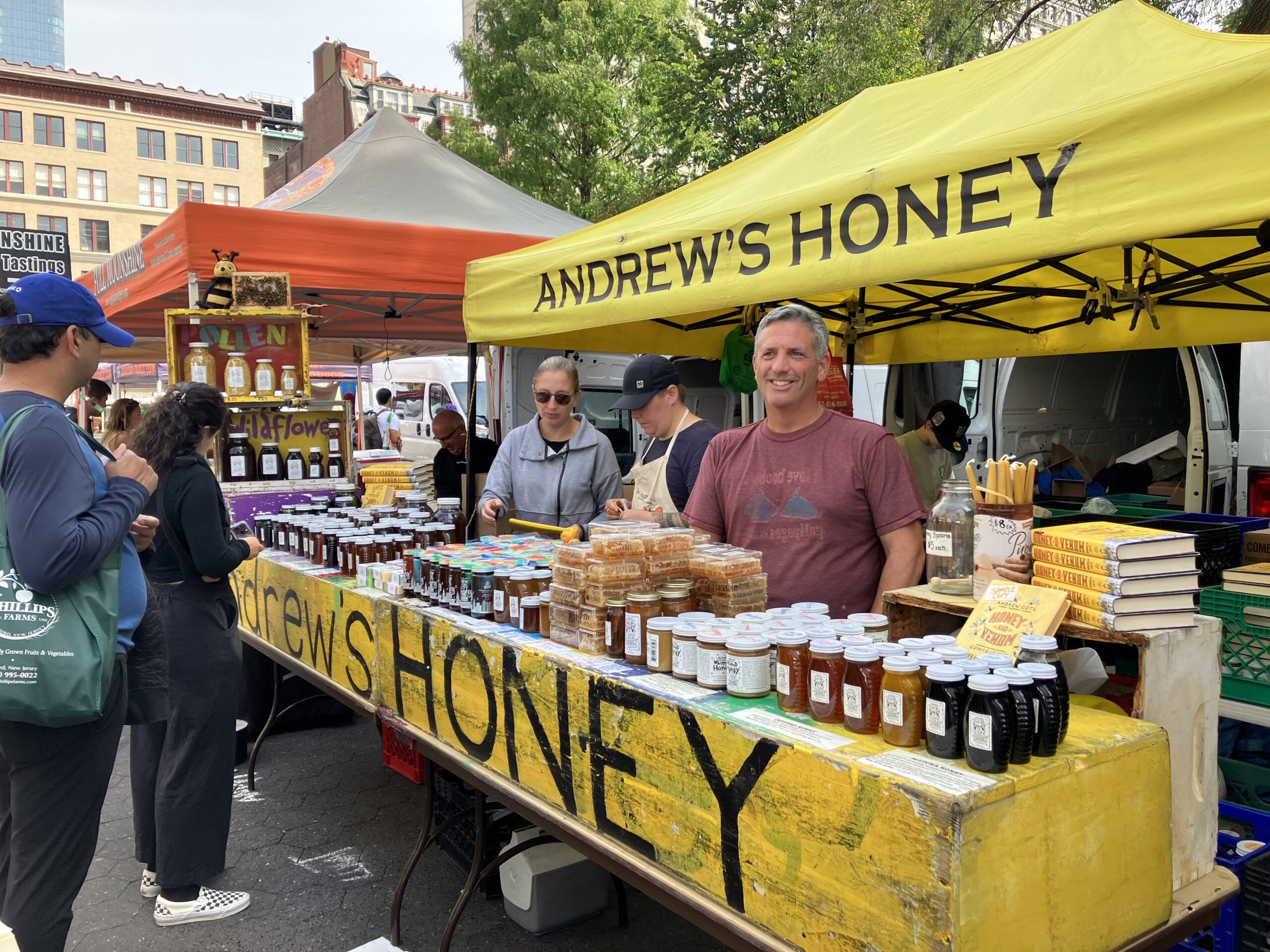Losing the scent
A new study suggests air pollution is changing flowers’ scents, throwing bees off-course
Carrie Klein • January 25, 2024

Andrew Coté, a New York City beekeeper, at his booth at the Union Square Greenmarket. Coté sells honey made from hives scattered across NYC rooftops. [Credit: Carrie Klein]
Flowers are smelling different—at least to bees. A recent study finds that air pollution is altering the smell of flowers, making it more difficult for honeybees to find and pollinate plants.
“Insects have got it tough already,” said Ben Langford, an atmospheric scientist at the UK Centre for Ecology & Hydrology and lead author of the study. “I mean, they’re dealing with habitat loss, climate change, pesticides—so this is really just one more challenge for them to overcome.”
Langford’s findings, published Aug. 16 in the journal Environmental Pollution, offer a possible answer to a mysterious effect he observed in a previous experiment: After he exposed honeybees to ozone, a key component of urban smog, the number of flowers they visited fell by a startling 90%.
To figure out why, Langford and his collaborators mixed ozone with chemicals mimicking the odor of flowers. They discovered that ozone chemically reacts with a flower’s odor, changing its scent. Ozone even alters the shape, size and structure of what’s known as the odor plume—like an invisible cloud of flowery scent—making it thinner, smaller and harder for bees to detect.
Honeybee experts said these results are potentially significant, especially at a time when insects are facing so many other threats.
“The effects of ozone pollution on plants or insects are generally ignored, but this study provides a very novel angle to see how this pollution disturbs the interactions between plants and animals,” said Xujiang He, a researcher at the Honeybee Research Institute of Jiangxi Agricultural University in China, who was not affiliated with the study.
Biologists have long known that some insects rely on smell to pollinate. Langford’s flower odor experiment showed how bees learn to remember certain scents, a skill that allows them to return to flowers that give the most nectar.
When Langford’s team exposed bees to the chemical flower odors, they simultaneously gave the bees a sugary reward. When met with the treat, the bees stuck out their tongues—just as they would do when feeding on a flower’s nectar. The researchers then exposed bees to the same odor, but with no reward. Still, the bees stuck out their tongues.
“So you can tell that they’ve remembered [the scent],” Langford said. “I didn’t realize you could train bees in the same way you can with dogs.”
Bees have good memories in other ways too. They’ve been shown to remember visual elements in their surroundings, like roads and vertical landmarks. That could explain why New York City beekeeper Andrew Coté said he sees his bees return to their hives each night after exploring the city.
Coté manages hives on rooftops across all five NYC boroughs. On weekends at the Union Square Greenmarket, he can be found selling honey, surrounded by a buzz of bees. The bees around his stand, he said, “are probably from the seven bee hives I have at 19th and Broadway.”
Coté’s bees pollinate many of the city’s trees and flowers. He estimates they fly around three miles or more in every direction from their hives, although most bees tend to stay closer depending on the availability of food sources. But if a bee can’t recognize the scent of a flower it has come to know, as Langord’s study suggests, it may not return to that species.
Eventually, bees are likely to find alternate flowers and learn to associate nectar with that new odor, Langford said—unless that odor is also disturbed by pollution. In the long run, this means bees could have to work harder to find food, Langford explained, exerting more energy than if a flower’s scent was left undisturbed.
If bees end up pollinating fewer flowers, it would not only affect NYC’s trees and flowering plants, but it could also have “significant implications for agricultural crops that depend on honeybee pollination, potentially reducing crop yields and quality,” said Elena Zioga, a doctoral student at Trinity College Dublin specializing in the effect of pesticides on honeybees, also unaffiliated with the study.
In the US alone, more than $18 billion worth of crops depend on bees. Honeybee products add an additional $700 million in value to the nation’s economy, according to the US Dept. of Agriculture. But honeybees are already facing a fistful of threats, including pesticide exposure and colony collapse disorder (a phenomenon where a colony’s worker bee population suddenly dies, leading to the downfall of the entire colony).
In the same way that ozone reacts with flower odors to alter their smells, different pollutants can interact in the atmosphere, potentially amplifying the risks they pose to insects like bees. “Pesticide research may need to account for the additional stress introduced by other air pollutants,” Zioga said.
The reaction rate of the chemicals in flower odors “depends on the concentration of ozone,” Langford said. The higher the ozone concentration, the quicker the chemicals will react. As they change, there’s less chance a bee will get a whiff of a flower’s scent. If they do, they may not recognize it—and likely won’t pollinate that flower.
One concerning factor in Langford’s results is that even at ozone levels deemed safe under UK regulations, flower odors were still transformed and still resulted in lower rates of scent recognition. Hot, sunny days in urban environments can easily bring ozone levels above so-called healthy levels. On days like this, Langford said a flower’s odor plume will only change more rapidly.
“No one’s ever really looked in detail at odor plumes and how that plume’s shape and structure changes as it’s reacting with ozone in real-time in the atmosphere,” Langford said. “It’s actually quite staggering when you get that data in and really see the magnitude of the harm air pollution is causing our insects.”